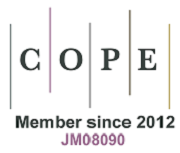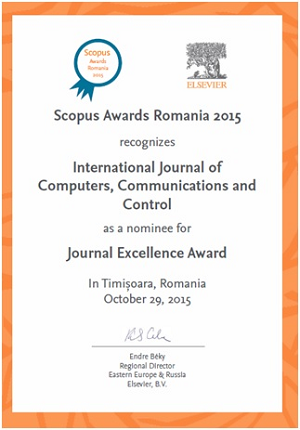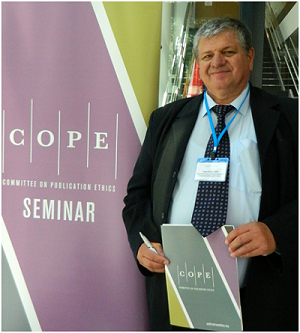Technical Solution for a Real-Time Air Quality Monitoring System
Keywords:
wireless sensors network, air quality monitoring, LoRaWANAbstract
This article will present a simple technical solution for a low-power and real-time air quality monitoring system. The whole package of software and hardware technical solutions applied for recording, transmitting and analyzing data is briefly described. This original monitoring system integrates a single chip microcon-troller, several dedicated air pollution surveillance sensors (for PM10, PM2.5, SO2, NO2, CO, O3, VOC, CO2), a LoRaWAN communication module and an online platform. This system was tested and applied under real field conditions. Depending on the measured values, it provides alerts, or, it can lead to the re-placement of specific components in the exhaust equipment. This article will pre-sent some experimental results, validated also by official measurements of government operated air quality stations.References
Arroyo, P.; Herrero, J.L.; Suárez, J.I.; Lozano, J. (2019). Wireless Sensor Network Combined with Cloud Computing for Air Quality Monitoring, Sensors, 19(3), 1-17, 2019. https://doi.org/10.3390/s19030691
Borrego, C.; Costa, A.M.; Ginja, J.; Amorim, M.et al. (2016). Assessment of air quality microsensors versus reference methods: The EuNetAir joint exercise, Atmospheric Environment, 147, 246-263, 2016. https://doi.org/10.1016/j.atmosenv.2016.09.050
Castell, N.; Dauge, F.R.; Schneider, F. et al. (2017). Can commercial low-cost sensor platforms contribute to air quality monitoring and exposure estimates?, Environment International, 99, 293-302, 2017. https://doi.org/10.1016/j.envint.2016.12.007
Hasenfratz, D.; Saukh, O.; Walser, C. et al. (2016). Deriving high-resolution urban air pollution maps using mobile sensor nodes, Pervasive and Mobile Computing, 16(B), 268-285, 2016. https://doi.org/10.1016/j.pmcj.2014.11.008
Honeywell (2018). HPM Series Particulate Matter Sensors, Honeywell, 2018.
Johnston, S.J.; Basford, P.J.; Bulot, F.M.J. et al. (2019). City Scale Particulate Matter Monitoring Using LoRaWAN Based Air Quality IoT Devices, Sensors, 19(1), 1-20, 2019 https://doi.org/10.3390/s19010209
Lee, S.; Lim, S. B. (2015). Applications of Ubiquitous Sensor Network: Micro-Scale Air Quality Monitoring, International Journal of Computers Communications & Control , 10(3), 370-381, 2015. https://doi.org/10.15837/ijccc.2015.3.889
Mo, X.; Zhang, L.; Li, H.; Qu, Z. (2019). A Novel Air Quality Early-Warning System Based on Artificial Intelligence, Environmental Research and Public Health, 16(19), 1-25, 2019. https://doi.org/10.3390/ijerph16193505
Oprea, M.; Mihalache, S. F.; Popescu, M. (2017). Computational Intelligence-based PM2.5 Air Pollution Forecasting, International Journal of Computers Communications & Control , 12(3), 365-380, 2017. https://doi.org/10.15837/ijccc.2017.3.2907
Simo, A.; Barbulescu, C.; Salinschi, M. (2018). LoRaWAN based industrial emission monitoring with self-flying drone, In 18th International Multidisciplinary Scientific GeoConference , 503-510, 2018. https://doi.org/10.5593/sgem2018V/4.3/S11.060
Wang, S.Y.; Zou J.J.; Chen Y.R. et al. (2018). Long-Term Performance Studies of a LoRaWANBased PM2.5 Application on Campus, In 87th Vehicular Technology Conference (VTC Spring) , 1-6, 2018. https://doi.org/10.1109/VTCSpring.2018.8417489
Wesseling, J.; de Ruiter, H.; Blokhuis, C. et al.(2019). Development and Implementation of a Platform for Public Information on Air Quality, Sensor Measurements, and Citizen Science, Atmosphere, 10(8), 1-20, 2019. https://doi.org/10.3390/atmos10080445
Published
Issue
Section
License
ONLINE OPEN ACCES: Acces to full text of each article and each issue are allowed for free in respect of Attribution-NonCommercial 4.0 International (CC BY-NC 4.0.
You are free to:
-Share: copy and redistribute the material in any medium or format;
-Adapt: remix, transform, and build upon the material.
The licensor cannot revoke these freedoms as long as you follow the license terms.
DISCLAIMER: The author(s) of each article appearing in International Journal of Computers Communications & Control is/are solely responsible for the content thereof; the publication of an article shall not constitute or be deemed to constitute any representation by the Editors or Agora University Press that the data presented therein are original, correct or sufficient to support the conclusions reached or that the experiment design or methodology is adequate.







